HRM Assignment: Employee Behavior, HR Influence, and Ethics
VerifiedAdded on 2022/08/12
|10
|1868
|465
Homework Assignment
AI Summary
This HRM assignment addresses several key aspects of human resource management. It begins by comparing worker cooperation in manufacturing versus healthcare settings, exploring the challenges and facilitators of collaboration. The assignment then delves into the rise of age discrimination, discussing potential reasons for its increase and future trends. It further examines the impact of globalization on unethical behavior and the role of HR managers in promoting ethical conduct within organizations. The document explores how upper management can effectively communicate mission statements to employees and the influence of HR on organizational culture, both positively and negatively. It also includes examples of workplace issues and how HR departments have or have not resolved them, along with considerations for reviewing hiring decisions and strategies for improving employee retention. The assignment also considers the problems and advantages of gathering information from passive job seekers using social media and concludes with a discussion of behavioral interviews.
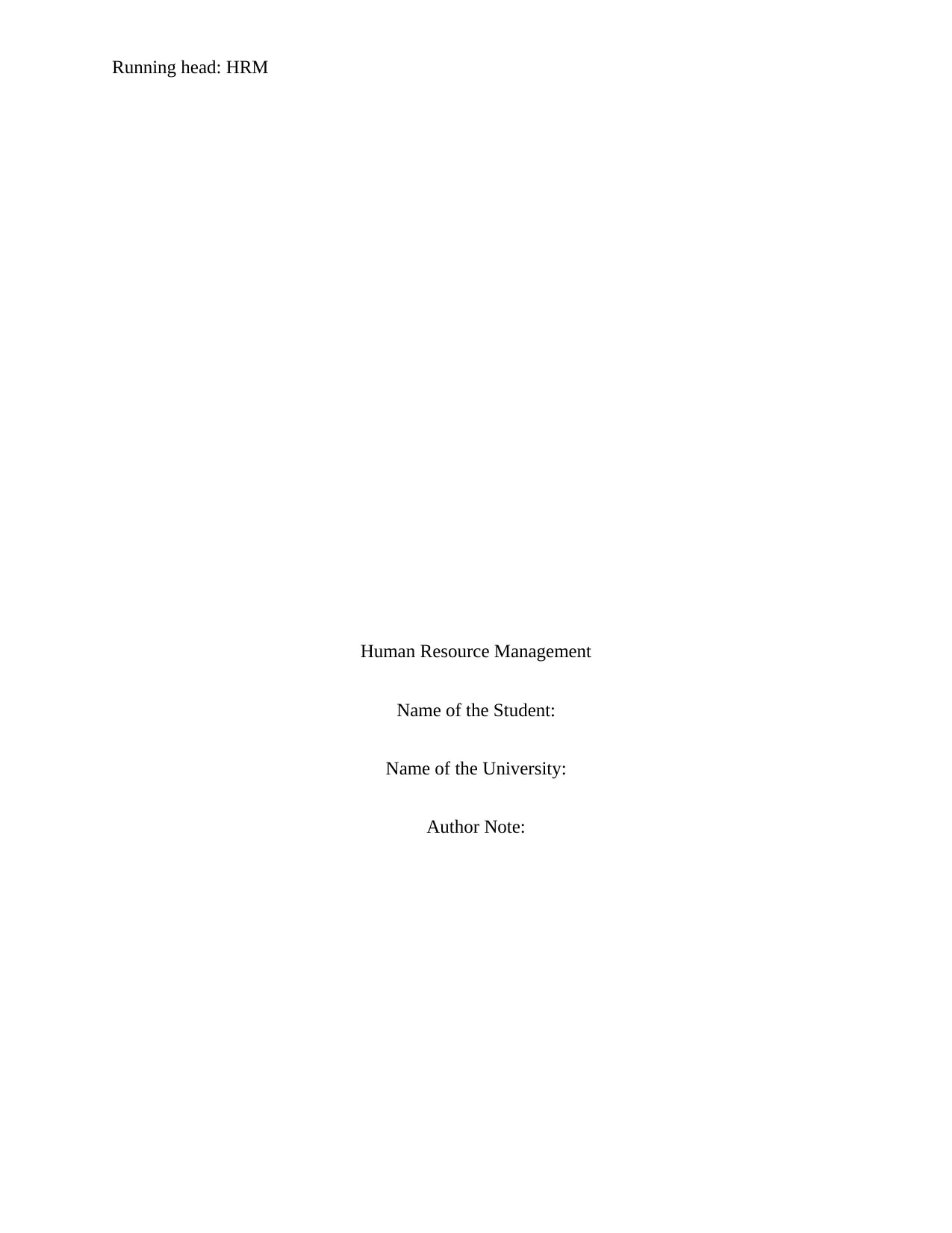
Running head: HRM
Human Resource Management
Name of the Student:
Name of the University:
Author Note:
Human Resource Management
Name of the Student:
Name of the University:
Author Note:
Paraphrase This Document
Need a fresh take? Get an instant paraphrase of this document with our AI Paraphraser
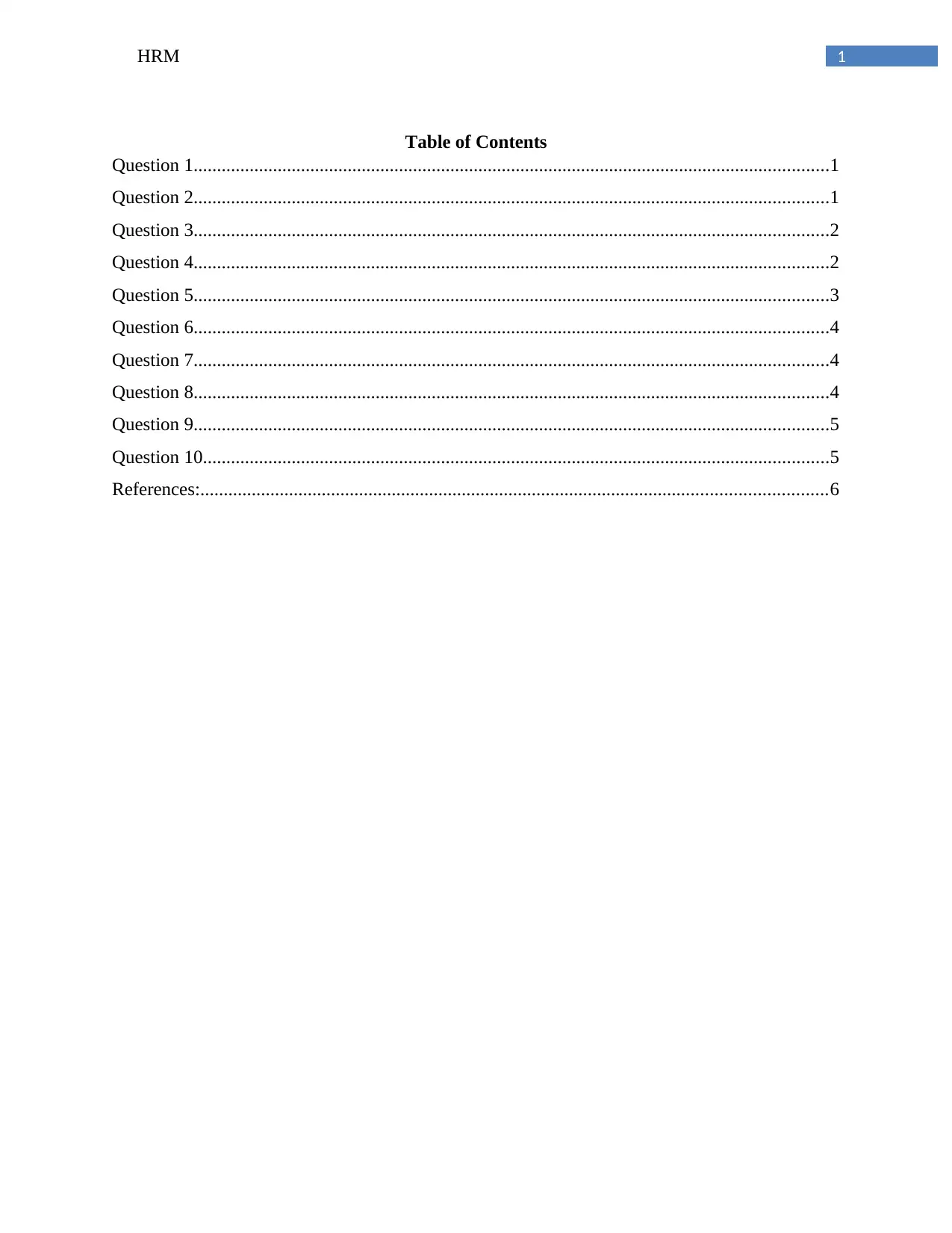
1HRM
Table of Contents
Question 1........................................................................................................................................1
Question 2........................................................................................................................................1
Question 3........................................................................................................................................2
Question 4........................................................................................................................................2
Question 5........................................................................................................................................3
Question 6........................................................................................................................................4
Question 7........................................................................................................................................4
Question 8........................................................................................................................................4
Question 9........................................................................................................................................5
Question 10......................................................................................................................................5
References:......................................................................................................................................6
Table of Contents
Question 1........................................................................................................................................1
Question 2........................................................................................................................................1
Question 3........................................................................................................................................2
Question 4........................................................................................................................................2
Question 5........................................................................................................................................3
Question 6........................................................................................................................................4
Question 7........................................................................................................................................4
Question 8........................................................................................................................................4
Question 9........................................................................................................................................5
Question 10......................................................................................................................................5
References:......................................................................................................................................6
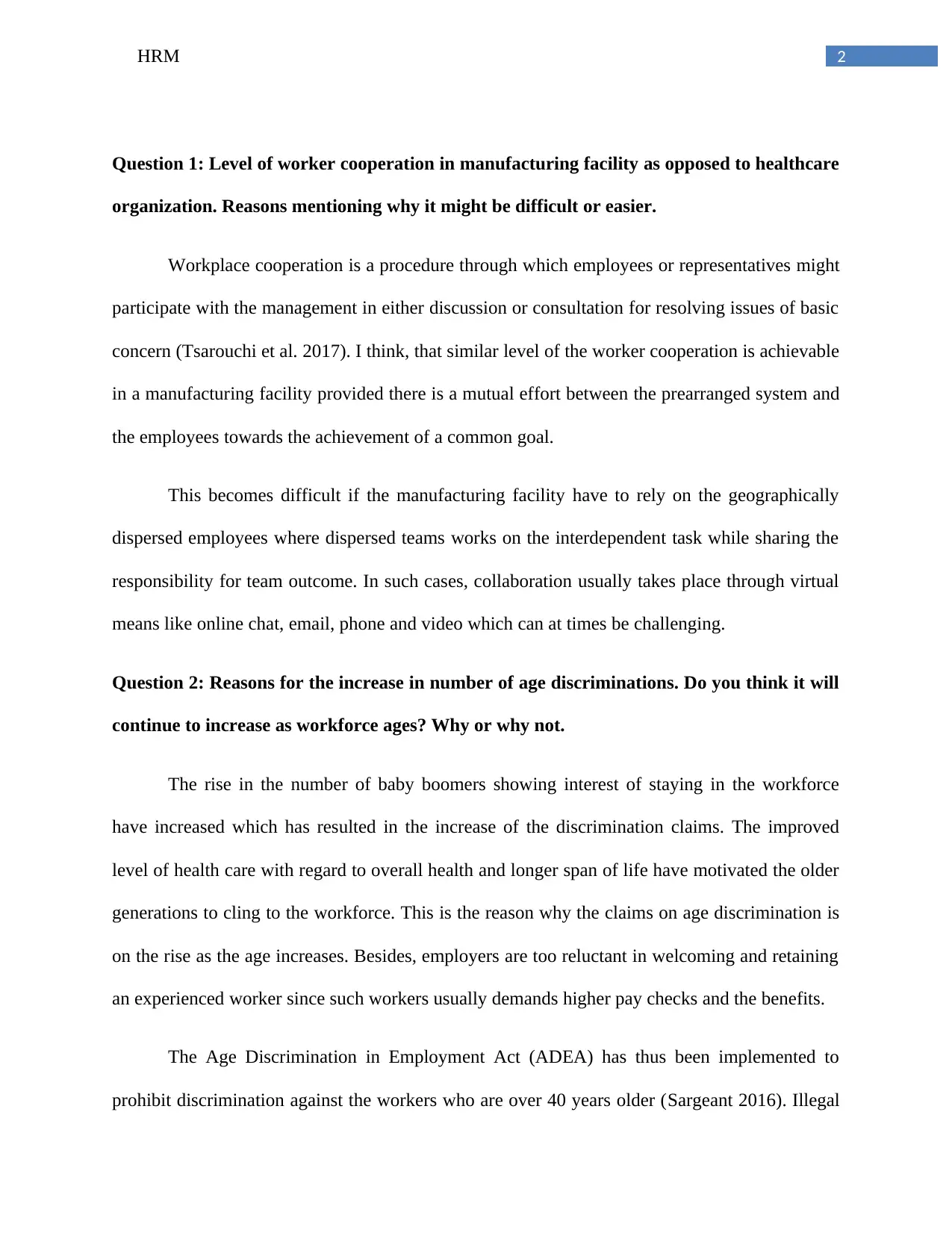
2HRM
Question 1: Level of worker cooperation in manufacturing facility as opposed to healthcare
organization. Reasons mentioning why it might be difficult or easier.
Workplace cooperation is a procedure through which employees or representatives might
participate with the management in either discussion or consultation for resolving issues of basic
concern (Tsarouchi et al. 2017). I think, that similar level of the worker cooperation is achievable
in a manufacturing facility provided there is a mutual effort between the prearranged system and
the employees towards the achievement of a common goal.
This becomes difficult if the manufacturing facility have to rely on the geographically
dispersed employees where dispersed teams works on the interdependent task while sharing the
responsibility for team outcome. In such cases, collaboration usually takes place through virtual
means like online chat, email, phone and video which can at times be challenging.
Question 2: Reasons for the increase in number of age discriminations. Do you think it will
continue to increase as workforce ages? Why or why not.
The rise in the number of baby boomers showing interest of staying in the workforce
have increased which has resulted in the increase of the discrimination claims. The improved
level of health care with regard to overall health and longer span of life have motivated the older
generations to cling to the workforce. This is the reason why the claims on age discrimination is
on the rise as the age increases. Besides, employers are too reluctant in welcoming and retaining
an experienced worker since such workers usually demands higher pay checks and the benefits.
The Age Discrimination in Employment Act (ADEA) has thus been implemented to
prohibit discrimination against the workers who are over 40 years older (Sargeant 2016). Illegal
Question 1: Level of worker cooperation in manufacturing facility as opposed to healthcare
organization. Reasons mentioning why it might be difficult or easier.
Workplace cooperation is a procedure through which employees or representatives might
participate with the management in either discussion or consultation for resolving issues of basic
concern (Tsarouchi et al. 2017). I think, that similar level of the worker cooperation is achievable
in a manufacturing facility provided there is a mutual effort between the prearranged system and
the employees towards the achievement of a common goal.
This becomes difficult if the manufacturing facility have to rely on the geographically
dispersed employees where dispersed teams works on the interdependent task while sharing the
responsibility for team outcome. In such cases, collaboration usually takes place through virtual
means like online chat, email, phone and video which can at times be challenging.
Question 2: Reasons for the increase in number of age discriminations. Do you think it will
continue to increase as workforce ages? Why or why not.
The rise in the number of baby boomers showing interest of staying in the workforce
have increased which has resulted in the increase of the discrimination claims. The improved
level of health care with regard to overall health and longer span of life have motivated the older
generations to cling to the workforce. This is the reason why the claims on age discrimination is
on the rise as the age increases. Besides, employers are too reluctant in welcoming and retaining
an experienced worker since such workers usually demands higher pay checks and the benefits.
The Age Discrimination in Employment Act (ADEA) has thus been implemented to
prohibit discrimination against the workers who are over 40 years older (Sargeant 2016). Illegal
⊘ This is a preview!⊘
Do you want full access?
Subscribe today to unlock all pages.

Trusted by 1+ million students worldwide
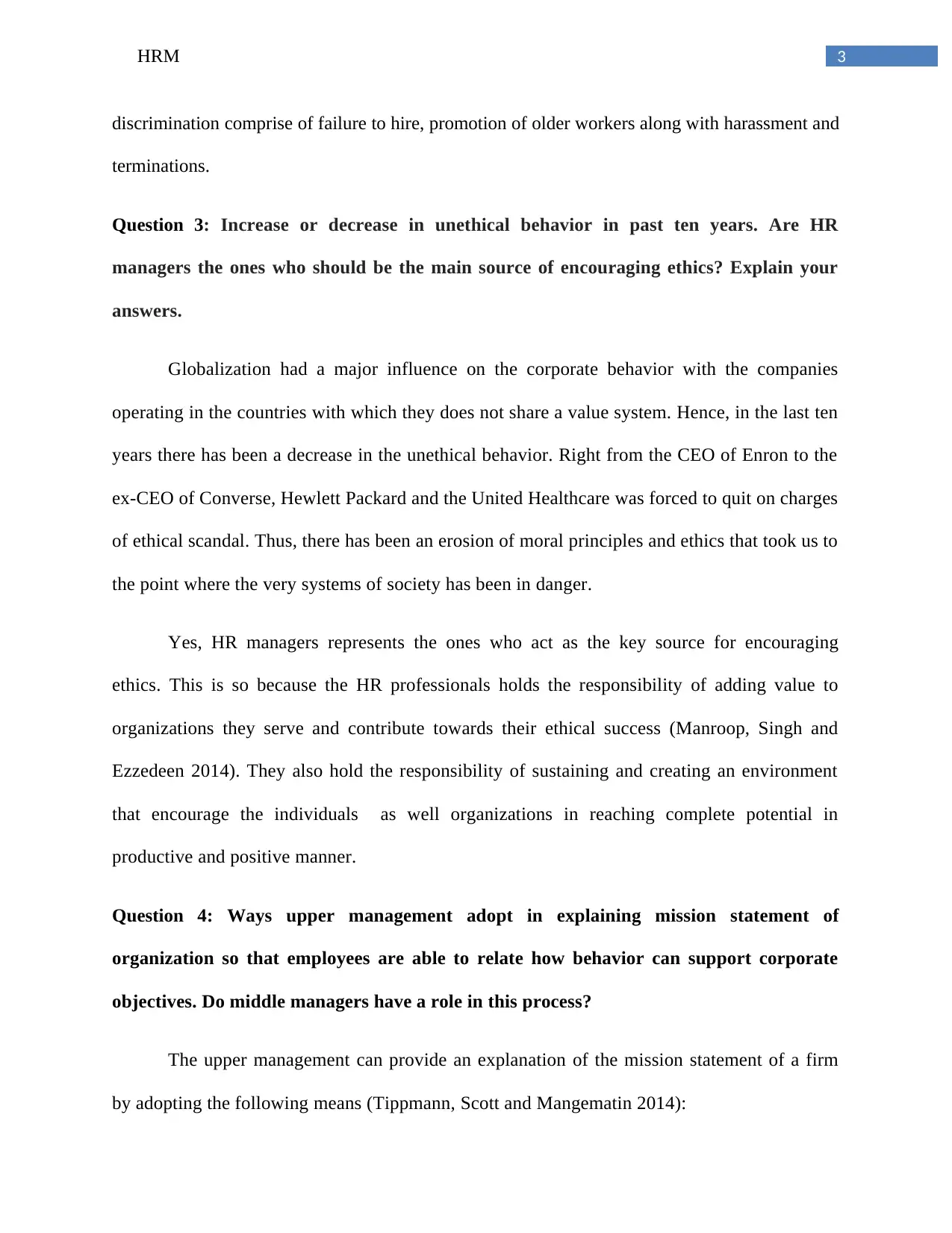
3HRM
discrimination comprise of failure to hire, promotion of older workers along with harassment and
terminations.
Question 3: Increase or decrease in unethical behavior in past ten years. Are HR
managers the ones who should be the main source of encouraging ethics? Explain your
answers.
Globalization had a major influence on the corporate behavior with the companies
operating in the countries with which they does not share a value system. Hence, in the last ten
years there has been a decrease in the unethical behavior. Right from the CEO of Enron to the
ex-CEO of Converse, Hewlett Packard and the United Healthcare was forced to quit on charges
of ethical scandal. Thus, there has been an erosion of moral principles and ethics that took us to
the point where the very systems of society has been in danger.
Yes, HR managers represents the ones who act as the key source for encouraging
ethics. This is so because the HR professionals holds the responsibility of adding value to
organizations they serve and contribute towards their ethical success (Manroop, Singh and
Ezzedeen 2014). They also hold the responsibility of sustaining and creating an environment
that encourage the individuals as well organizations in reaching complete potential in
productive and positive manner.
Question 4: Ways upper management adopt in explaining mission statement of
organization so that employees are able to relate how behavior can support corporate
objectives. Do middle managers have a role in this process?
The upper management can provide an explanation of the mission statement of a firm
by adopting the following means (Tippmann, Scott and Mangematin 2014):
discrimination comprise of failure to hire, promotion of older workers along with harassment and
terminations.
Question 3: Increase or decrease in unethical behavior in past ten years. Are HR
managers the ones who should be the main source of encouraging ethics? Explain your
answers.
Globalization had a major influence on the corporate behavior with the companies
operating in the countries with which they does not share a value system. Hence, in the last ten
years there has been a decrease in the unethical behavior. Right from the CEO of Enron to the
ex-CEO of Converse, Hewlett Packard and the United Healthcare was forced to quit on charges
of ethical scandal. Thus, there has been an erosion of moral principles and ethics that took us to
the point where the very systems of society has been in danger.
Yes, HR managers represents the ones who act as the key source for encouraging
ethics. This is so because the HR professionals holds the responsibility of adding value to
organizations they serve and contribute towards their ethical success (Manroop, Singh and
Ezzedeen 2014). They also hold the responsibility of sustaining and creating an environment
that encourage the individuals as well organizations in reaching complete potential in
productive and positive manner.
Question 4: Ways upper management adopt in explaining mission statement of
organization so that employees are able to relate how behavior can support corporate
objectives. Do middle managers have a role in this process?
The upper management can provide an explanation of the mission statement of a firm
by adopting the following means (Tippmann, Scott and Mangematin 2014):
Paraphrase This Document
Need a fresh take? Get an instant paraphrase of this document with our AI Paraphraser
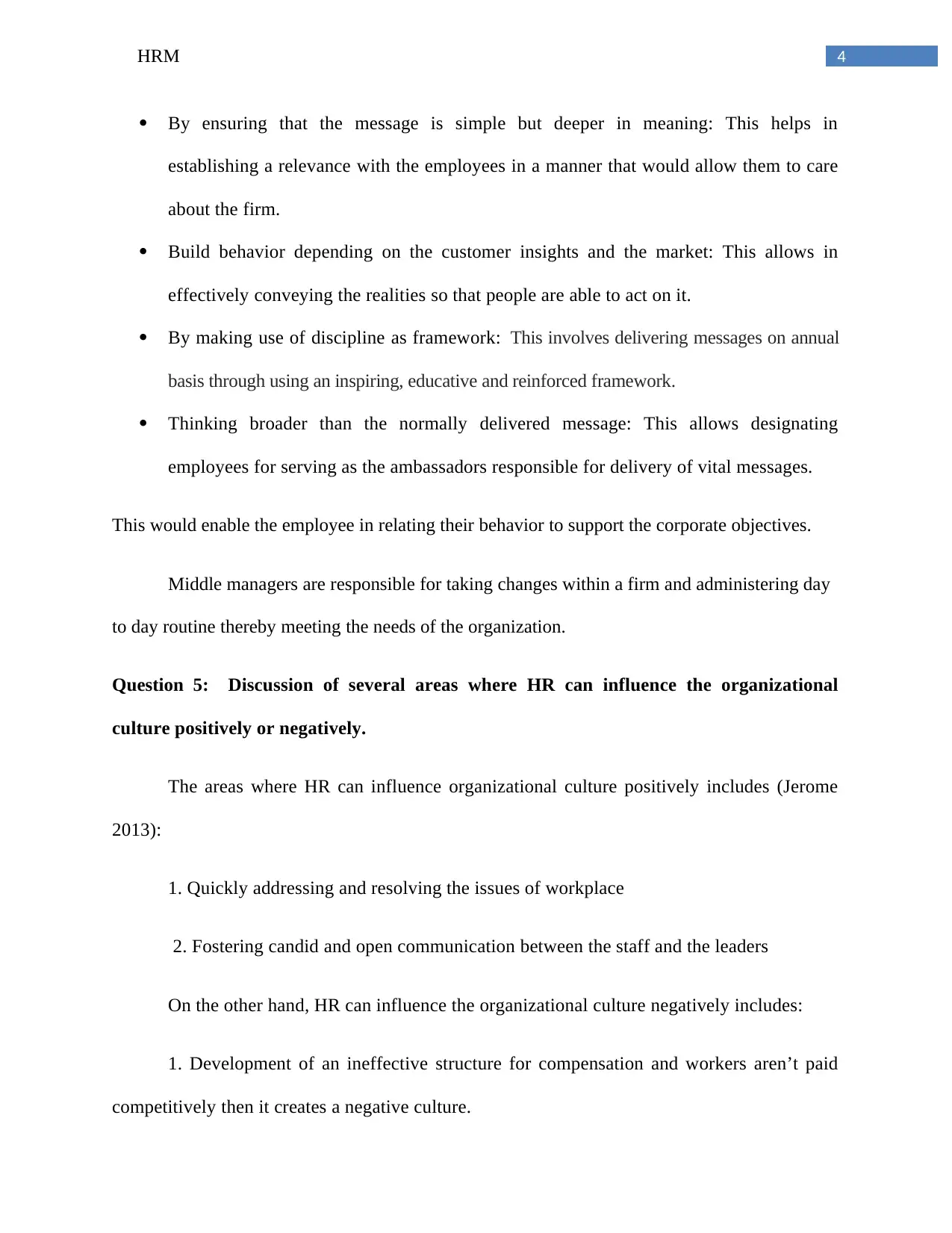
4HRM
By ensuring that the message is simple but deeper in meaning: This helps in
establishing a relevance with the employees in a manner that would allow them to care
about the firm.
Build behavior depending on the customer insights and the market: This allows in
effectively conveying the realities so that people are able to act on it.
By making use of discipline as framework: This involves delivering messages on annual
basis through using an inspiring, educative and reinforced framework.
Thinking broader than the normally delivered message: This allows designating
employees for serving as the ambassadors responsible for delivery of vital messages.
This would enable the employee in relating their behavior to support the corporate objectives.
Middle managers are responsible for taking changes within a firm and administering day
to day routine thereby meeting the needs of the organization.
Question 5: Discussion of several areas where HR can influence the organizational
culture positively or negatively.
The areas where HR can influence organizational culture positively includes (Jerome
2013):
1. Quickly addressing and resolving the issues of workplace
2. Fostering candid and open communication between the staff and the leaders
On the other hand, HR can influence the organizational culture negatively includes:
1. Development of an ineffective structure for compensation and workers aren’t paid
competitively then it creates a negative culture.
By ensuring that the message is simple but deeper in meaning: This helps in
establishing a relevance with the employees in a manner that would allow them to care
about the firm.
Build behavior depending on the customer insights and the market: This allows in
effectively conveying the realities so that people are able to act on it.
By making use of discipline as framework: This involves delivering messages on annual
basis through using an inspiring, educative and reinforced framework.
Thinking broader than the normally delivered message: This allows designating
employees for serving as the ambassadors responsible for delivery of vital messages.
This would enable the employee in relating their behavior to support the corporate objectives.
Middle managers are responsible for taking changes within a firm and administering day
to day routine thereby meeting the needs of the organization.
Question 5: Discussion of several areas where HR can influence the organizational
culture positively or negatively.
The areas where HR can influence organizational culture positively includes (Jerome
2013):
1. Quickly addressing and resolving the issues of workplace
2. Fostering candid and open communication between the staff and the leaders
On the other hand, HR can influence the organizational culture negatively includes:
1. Development of an ineffective structure for compensation and workers aren’t paid
competitively then it creates a negative culture.
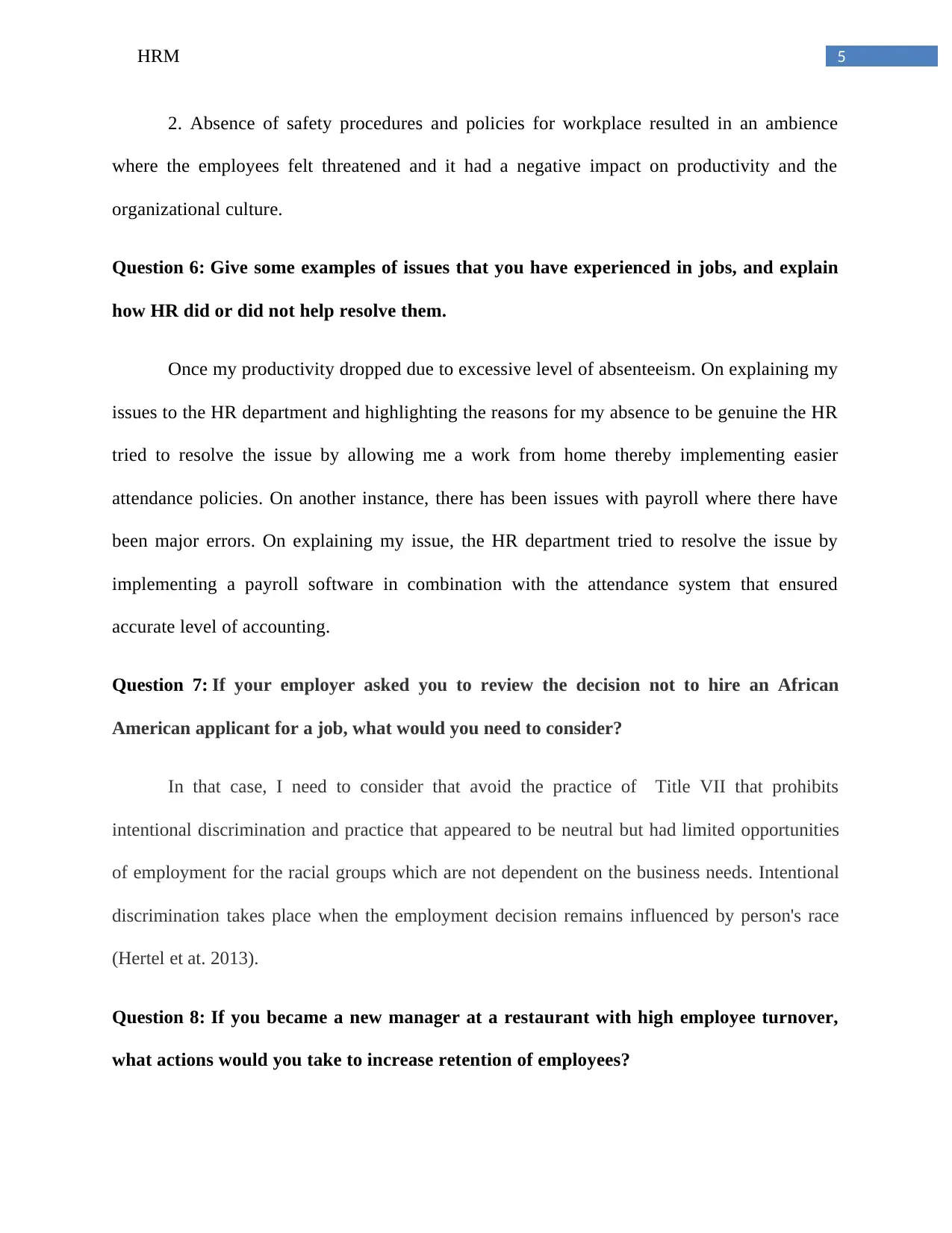
5HRM
2. Absence of safety procedures and policies for workplace resulted in an ambience
where the employees felt threatened and it had a negative impact on productivity and the
organizational culture.
Question 6: Give some examples of issues that you have experienced in jobs, and explain
how HR did or did not help resolve them.
Once my productivity dropped due to excessive level of absenteeism. On explaining my
issues to the HR department and highlighting the reasons for my absence to be genuine the HR
tried to resolve the issue by allowing me a work from home thereby implementing easier
attendance policies. On another instance, there has been issues with payroll where there have
been major errors. On explaining my issue, the HR department tried to resolve the issue by
implementing a payroll software in combination with the attendance system that ensured
accurate level of accounting.
Question 7: If your employer asked you to review the decision not to hire an African
American applicant for a job, what would you need to consider?
In that case, I need to consider that avoid the practice of Title VII that prohibits
intentional discrimination and practice that appeared to be neutral but had limited opportunities
of employment for the racial groups which are not dependent on the business needs. Intentional
discrimination takes place when the employment decision remains influenced by person's race
(Hertel et at. 2013).
Question 8: If you became a new manager at a restaurant with high employee turnover,
what actions would you take to increase retention of employees?
2. Absence of safety procedures and policies for workplace resulted in an ambience
where the employees felt threatened and it had a negative impact on productivity and the
organizational culture.
Question 6: Give some examples of issues that you have experienced in jobs, and explain
how HR did or did not help resolve them.
Once my productivity dropped due to excessive level of absenteeism. On explaining my
issues to the HR department and highlighting the reasons for my absence to be genuine the HR
tried to resolve the issue by allowing me a work from home thereby implementing easier
attendance policies. On another instance, there has been issues with payroll where there have
been major errors. On explaining my issue, the HR department tried to resolve the issue by
implementing a payroll software in combination with the attendance system that ensured
accurate level of accounting.
Question 7: If your employer asked you to review the decision not to hire an African
American applicant for a job, what would you need to consider?
In that case, I need to consider that avoid the practice of Title VII that prohibits
intentional discrimination and practice that appeared to be neutral but had limited opportunities
of employment for the racial groups which are not dependent on the business needs. Intentional
discrimination takes place when the employment decision remains influenced by person's race
(Hertel et at. 2013).
Question 8: If you became a new manager at a restaurant with high employee turnover,
what actions would you take to increase retention of employees?
⊘ This is a preview!⊘
Do you want full access?
Subscribe today to unlock all pages.

Trusted by 1+ million students worldwide
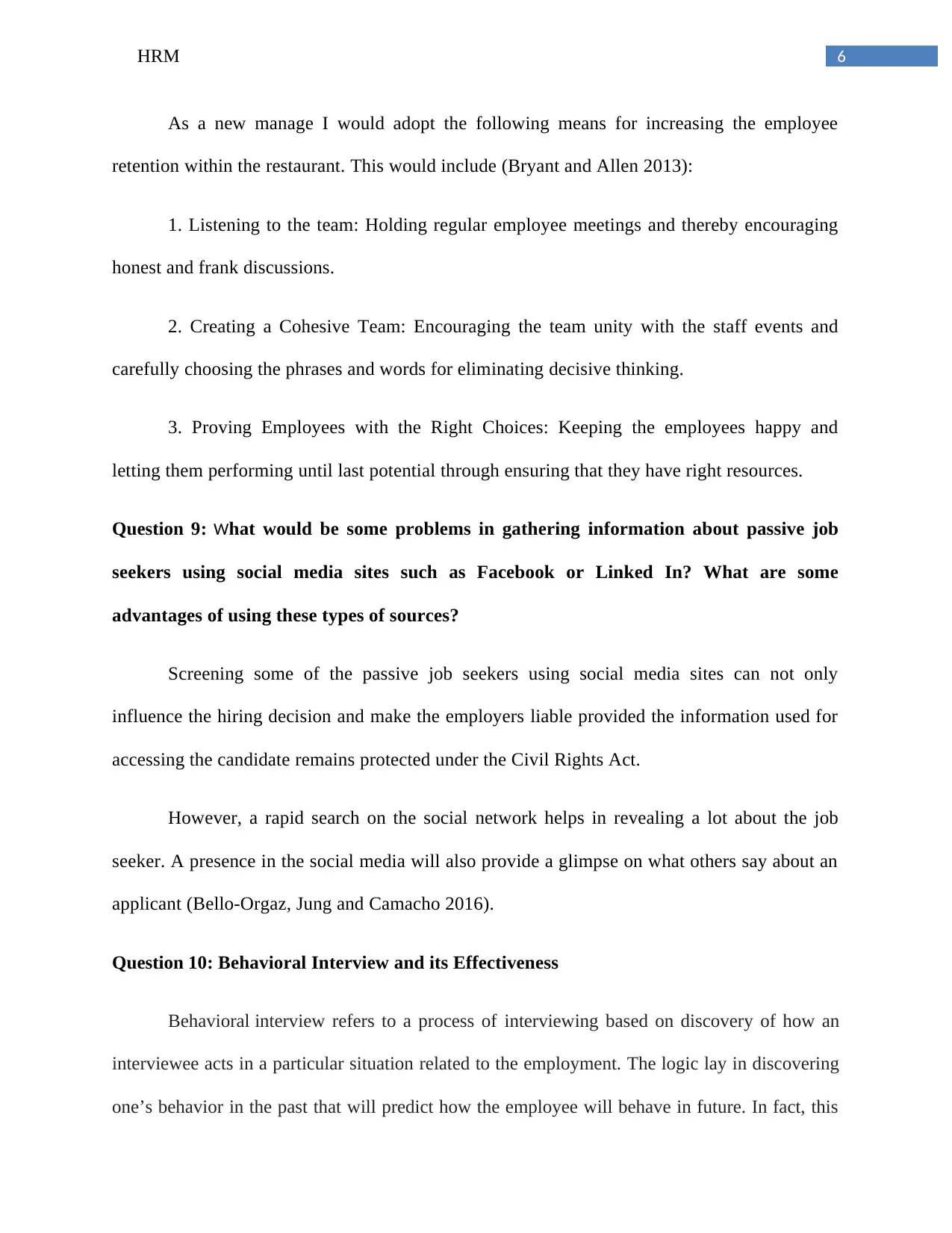
6HRM
As a new manage I would adopt the following means for increasing the employee
retention within the restaurant. This would include (Bryant and Allen 2013):
1. Listening to the team: Holding regular employee meetings and thereby encouraging
honest and frank discussions.
2. Creating a Cohesive Team: Encouraging the team unity with the staff events and
carefully choosing the phrases and words for eliminating decisive thinking.
3. Proving Employees with the Right Choices: Keeping the employees happy and
letting them performing until last potential through ensuring that they have right resources.
Question 9: What would be some problems in gathering information about passive job
seekers using social media sites such as Facebook or Linked In? What are some
advantages of using these types of sources?
Screening some of the passive job seekers using social media sites can not only
influence the hiring decision and make the employers liable provided the information used for
accessing the candidate remains protected under the Civil Rights Act.
However, a rapid search on the social network helps in revealing a lot about the job
seeker. A presence in the social media will also provide a glimpse on what others say about an
applicant (Bello-Orgaz, Jung and Camacho 2016).
Question 10: Behavioral Interview and its Effectiveness
Behavioral interview refers to a process of interviewing based on discovery of how an
interviewee acts in a particular situation related to the employment. The logic lay in discovering
one’s behavior in the past that will predict how the employee will behave in future. In fact, this
As a new manage I would adopt the following means for increasing the employee
retention within the restaurant. This would include (Bryant and Allen 2013):
1. Listening to the team: Holding regular employee meetings and thereby encouraging
honest and frank discussions.
2. Creating a Cohesive Team: Encouraging the team unity with the staff events and
carefully choosing the phrases and words for eliminating decisive thinking.
3. Proving Employees with the Right Choices: Keeping the employees happy and
letting them performing until last potential through ensuring that they have right resources.
Question 9: What would be some problems in gathering information about passive job
seekers using social media sites such as Facebook or Linked In? What are some
advantages of using these types of sources?
Screening some of the passive job seekers using social media sites can not only
influence the hiring decision and make the employers liable provided the information used for
accessing the candidate remains protected under the Civil Rights Act.
However, a rapid search on the social network helps in revealing a lot about the job
seeker. A presence in the social media will also provide a glimpse on what others say about an
applicant (Bello-Orgaz, Jung and Camacho 2016).
Question 10: Behavioral Interview and its Effectiveness
Behavioral interview refers to a process of interviewing based on discovery of how an
interviewee acts in a particular situation related to the employment. The logic lay in discovering
one’s behavior in the past that will predict how the employee will behave in future. In fact, this
Paraphrase This Document
Need a fresh take? Get an instant paraphrase of this document with our AI Paraphraser
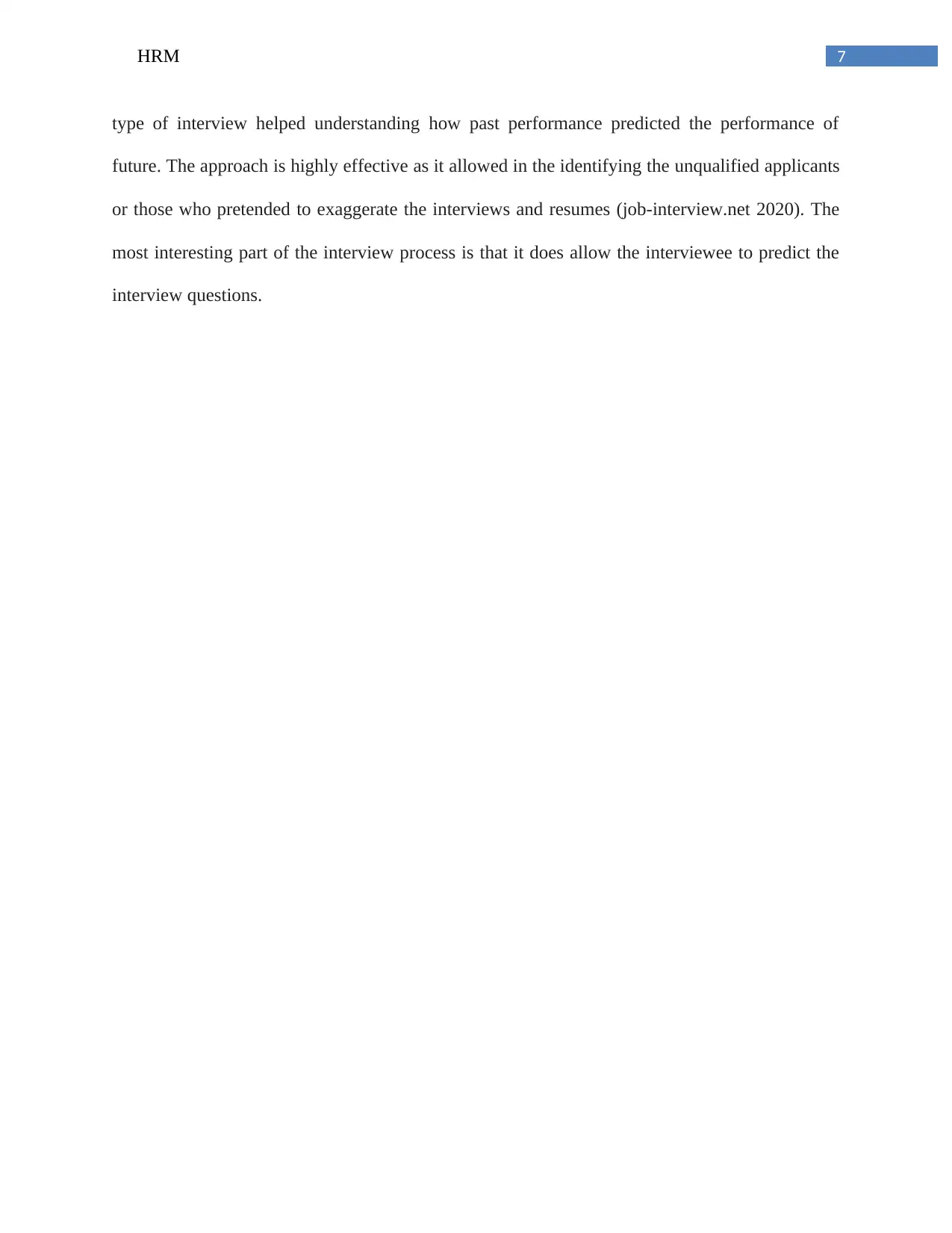
7HRM
type of interview helped understanding how past performance predicted the performance of
future. The approach is highly effective as it allowed in the identifying the unqualified applicants
or those who pretended to exaggerate the interviews and resumes (job-interview.net 2020). The
most interesting part of the interview process is that it does allow the interviewee to predict the
interview questions.
type of interview helped understanding how past performance predicted the performance of
future. The approach is highly effective as it allowed in the identifying the unqualified applicants
or those who pretended to exaggerate the interviews and resumes (job-interview.net 2020). The
most interesting part of the interview process is that it does allow the interviewee to predict the
interview questions.
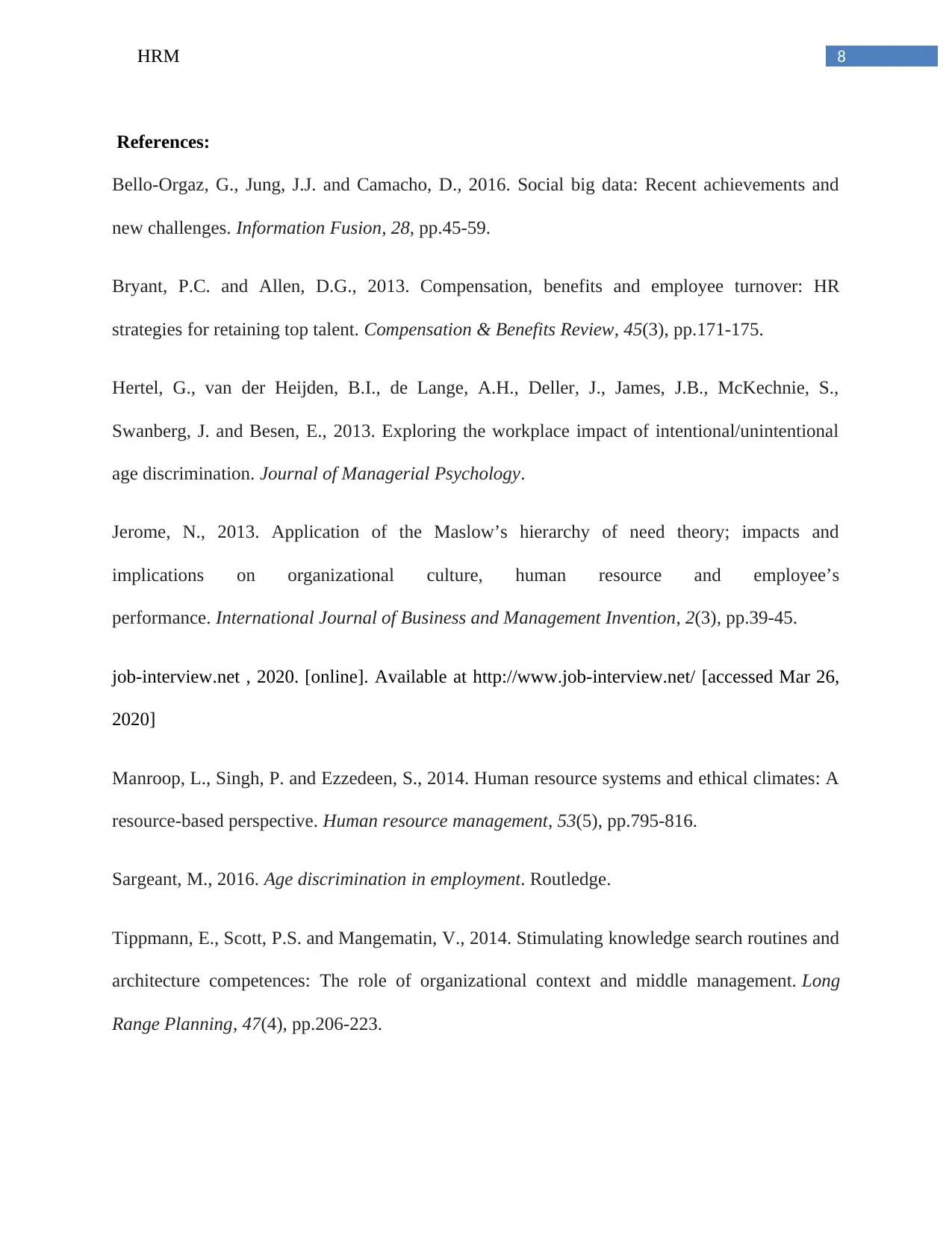
8HRM
References:
Bello-Orgaz, G., Jung, J.J. and Camacho, D., 2016. Social big data: Recent achievements and
new challenges. Information Fusion, 28, pp.45-59.
Bryant, P.C. and Allen, D.G., 2013. Compensation, benefits and employee turnover: HR
strategies for retaining top talent. Compensation & Benefits Review, 45(3), pp.171-175.
Hertel, G., van der Heijden, B.I., de Lange, A.H., Deller, J., James, J.B., McKechnie, S.,
Swanberg, J. and Besen, E., 2013. Exploring the workplace impact of intentional/unintentional
age discrimination. Journal of Managerial Psychology.
Jerome, N., 2013. Application of the Maslow’s hierarchy of need theory; impacts and
implications on organizational culture, human resource and employee’s
performance. International Journal of Business and Management Invention, 2(3), pp.39-45.
job-interview.net , 2020. [online]. Available at http://www.job-interview.net/ [accessed Mar 26,
2020]
Manroop, L., Singh, P. and Ezzedeen, S., 2014. Human resource systems and ethical climates: A
resource‐based perspective. Human resource management, 53(5), pp.795-816.
Sargeant, M., 2016. Age discrimination in employment. Routledge.
Tippmann, E., Scott, P.S. and Mangematin, V., 2014. Stimulating knowledge search routines and
architecture competences: The role of organizational context and middle management. Long
Range Planning, 47(4), pp.206-223.
References:
Bello-Orgaz, G., Jung, J.J. and Camacho, D., 2016. Social big data: Recent achievements and
new challenges. Information Fusion, 28, pp.45-59.
Bryant, P.C. and Allen, D.G., 2013. Compensation, benefits and employee turnover: HR
strategies for retaining top talent. Compensation & Benefits Review, 45(3), pp.171-175.
Hertel, G., van der Heijden, B.I., de Lange, A.H., Deller, J., James, J.B., McKechnie, S.,
Swanberg, J. and Besen, E., 2013. Exploring the workplace impact of intentional/unintentional
age discrimination. Journal of Managerial Psychology.
Jerome, N., 2013. Application of the Maslow’s hierarchy of need theory; impacts and
implications on organizational culture, human resource and employee’s
performance. International Journal of Business and Management Invention, 2(3), pp.39-45.
job-interview.net , 2020. [online]. Available at http://www.job-interview.net/ [accessed Mar 26,
2020]
Manroop, L., Singh, P. and Ezzedeen, S., 2014. Human resource systems and ethical climates: A
resource‐based perspective. Human resource management, 53(5), pp.795-816.
Sargeant, M., 2016. Age discrimination in employment. Routledge.
Tippmann, E., Scott, P.S. and Mangematin, V., 2014. Stimulating knowledge search routines and
architecture competences: The role of organizational context and middle management. Long
Range Planning, 47(4), pp.206-223.
⊘ This is a preview!⊘
Do you want full access?
Subscribe today to unlock all pages.

Trusted by 1+ million students worldwide

9HRM
Tsarouchi, P., Michalos, G., Makris, S., Athanasatos, T., Dimoulas, K. and Chryssolouris, G.,
2017. On a human–robot workplace design and task allocation system. International Journal of
Computer Integrated Manufacturing, 30(12), pp.1272-1279.
Tsarouchi, P., Michalos, G., Makris, S., Athanasatos, T., Dimoulas, K. and Chryssolouris, G.,
2017. On a human–robot workplace design and task allocation system. International Journal of
Computer Integrated Manufacturing, 30(12), pp.1272-1279.
1 out of 10
Your All-in-One AI-Powered Toolkit for Academic Success.
+13062052269
info@desklib.com
Available 24*7 on WhatsApp / Email
![[object Object]](/_next/static/media/star-bottom.7253800d.svg)
Unlock your academic potential
Copyright © 2020–2025 A2Z Services. All Rights Reserved. Developed and managed by ZUCOL.
